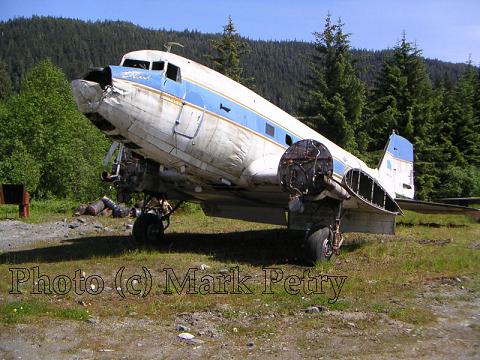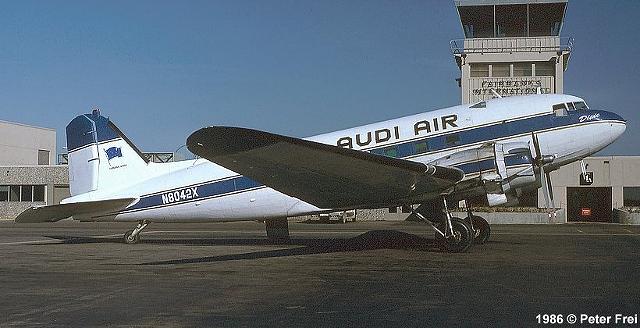

Peter Frei of Switzerland made a trip to Alaska during 1986 in Fairbanks, and photographed Audi Air DC-3, N8042X "Dixie" in perfect flying condition. My thanks to Peter for the permission he gave to use his picture here. Amazing to see below, what we discovered 13 years later in Petersburg, Alaska.
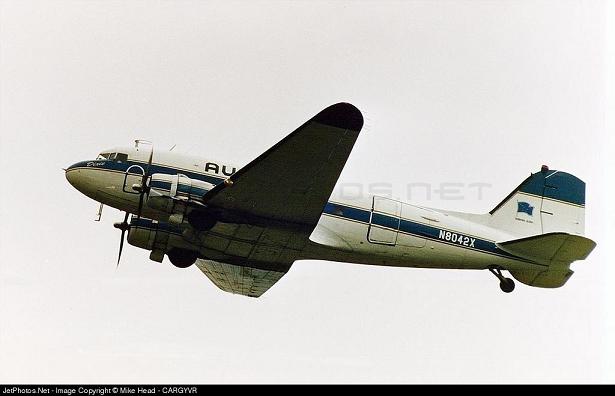
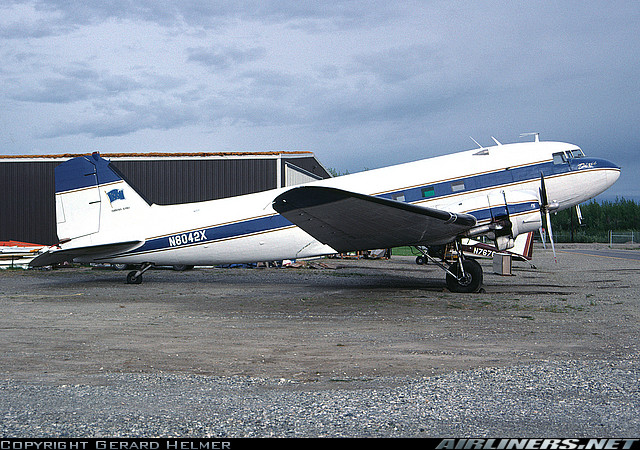
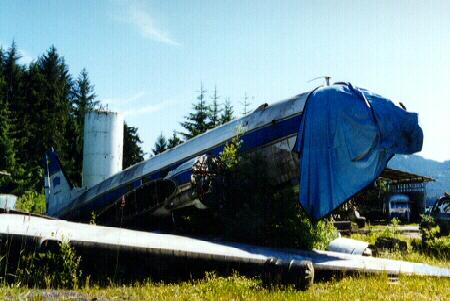
During our vacation in Alaska, July, 1999, my wife Kimm and I, spent a week in a small fishing town named Petersburg. We wanted to spend an entire week here whale watching. Petersburg, a beatiful small town, overlooks Frederick Sound. Late in the day, we had spotted a pod of seven large Orca Killer whales swimming South toward the Wrangell Narrows. We had our Camera's in hand and we were very excited. After they swam by, we decided to get another look at them by driving a mile down the road from another point overlooking Frederick Sound. Once we got there, we realized to get to the point, we had to walk through a scrap yard. And so, we did. The pod of Orca Killer whales swam by again and even closer than before. We were both very excited, as this was our first whale spotting of the week. We captured great video footage and photographs of them swimming by. Once our cameras were packed away, we turned to head to our car and make our way through the scrap yard again. Imagine my face when after turning around after seeing the whales which was such a beautiful site, right in front of me, was a derilict DC-3. I had decided to conduct some research on this DC-3 throughout the week and it was not easy. I felt like a reporter interviewing the locals about this strange and mysterious DC-3 in Petersburg. However, the locals obliged by giving me every bit of information I needed.
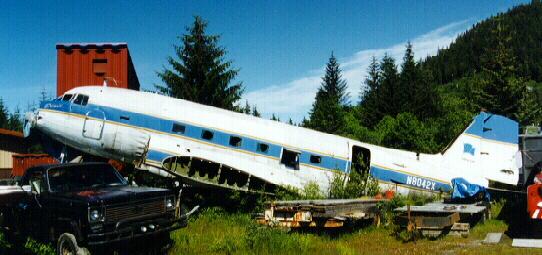
The DC-3, named "Dixie"(actually a C-47 built in 1943) and in cargo configuration was N8042X (s/n 19041) and had the livery of Fairbanks, Alaska upon it. In June of 1988, the DC-3 had been purchased by California Air Tours from Fairbanks and it was to be flown from Petersburg to Burbank, California. On Monday, June 26th 1988, shortly after taking off, the Captain lost control of the aircraft (it was discovered that the chain from the left yoke had snapped) and rather than head back to Petersburg Airport and take the risk of crashing into mountainous terrain, it was decided to ditch it, 6 miles South of Petersburg into the Wrangell Narrows. What the Captain did not realize is, that the co-pilot's yoke could have controlled the aircraft just fine, but in the panic, it was not realized. The DC-3 was ditched and both the crew were able to escape unharmed. The DC-3 stayed afloat for about 15 minutes before sinking eighty-three feet, nose down into the water. It was later learned that the co-pilot was actually an aircraft engineer, therefore, the perfectly working right yoke was probably a further oversight, because of the in-experience in the right seat.
Still, ditching the DC-3 in the water seemed to be the right call at the time. Any San Diego personal injury lawyer knows the risk of personal injury is much greater crashing into mountainous terrain than into water.
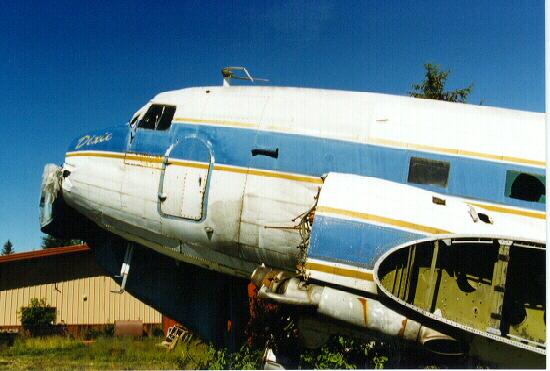
Five days after the crash the date being 6th July, 1988, the salvage operation began, to drag the DC-3 up from the Wrangell Narrows. Dave Berg and FredTriem, locals of Petersburg, purchased the ditched plane from an insurance company and there was somewhat of a contraversey involving who actually owned it. A lawyer stepped in, claiming salvage rights was pefectly legal. Amazingly, the DC-3 was in excellent conditition when it was brought up by a crane, a marine barge and divers. The DC-3 frame had a total of 10,849 hours and the engines were P&W 1830-94's. The left engine was quite new with only 7 hours on it. The right engine had 756 hours.
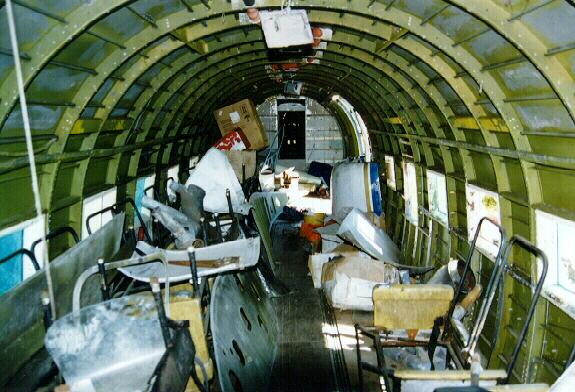
After it was brought to dry land, it was thought that the owners had about $200,000 worth of aircraft in good condition. The idea was to have the engines running within a week. The very next day, however, the owners were offered $100,000 for the DC-3 and they turned it down, perhaps because they thought it was below the price they wanted or, they higher offers would come later. A true effort was made to get new props and have the engines overhauled, but later that year, with wings removed, it has laid there ever since, rotting away in the scrap yard. I spoke with one of the owners Dave Berg who manages a travel agency in the town, a nice gentleman who helped on my research for this DC-3. He seems to no longer have any interest in the grand old bird and I even pondered myself, if I could put it to use. It is hoped someone in Petersburg will. There are many options for one who has ingenuity, and personally, I thought of using the fuselage as an entrance to a bar that focus's on Alaskan Aviation, both the locals and the tourists in Petersburg would just love it and there is certainly money to be made from such a venture, not to mention putting the DC-3 to some good use at the same time.
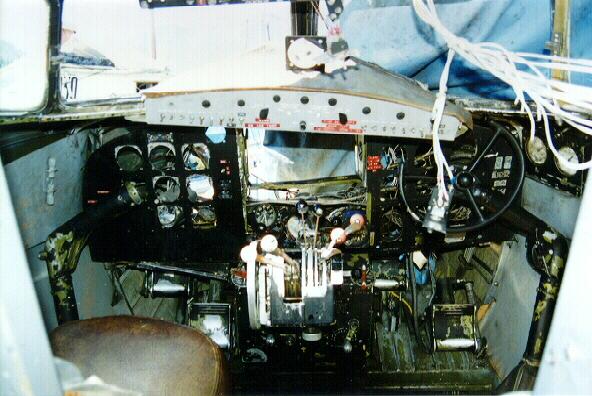
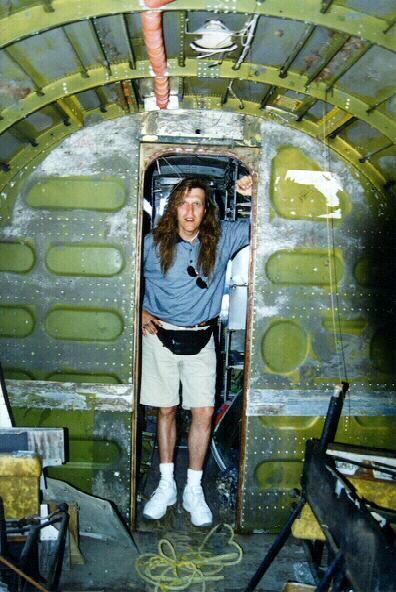
As you can see above, the interior after 10 years is not in too a bad shape, considering the circumstances, although the cockpit needs a lot of work indeed. Petesburg was a fun town and outside of whale watching (which was the reason we spent a week there), it was the perfect place to spend vacation before moving on to other parts of Alaska in search of wild life and.... perhaps more surprise DC-3's.
The latest news as of May 27th 2000, apparently the original owner of the DC-3 had an agent deliver a check to the state the day before the auction was scheduled. The agent, The Southeast Alaska Regional Air Show, is making arrangements to have the plane removed from the site. Turns out the Petersburg DC3 is moving to be displayed outside the airport in Juneau, Alaska, JNU, on a pedistal.
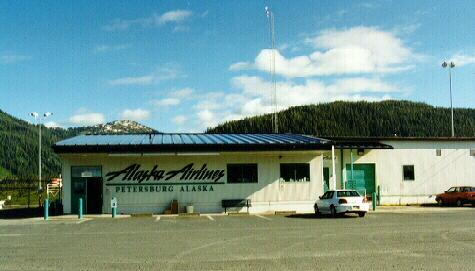
The following Article was contributed with permission by JOAN PARDES of THE JUNEAU EMPIRE
Even though she's going to need a lot of work and may never fly again, local aviation enthusiasts can't wait until Dixie, a ditched Douglas DC-3, hops a barge from Petersburg and heads north to Juneau.
Almost 11 years ago, the plane became a part of Petersburg folklore when she crashed into the nearby Wrangell Narrows.
A group of Juneau aviators recently purchased the vintage World War II-era aircraft and plan to resurrect her as a monument to Alaska's aviation history.
We want to make her a showpiece somewhere in Juneau. Hopefully at the airport as a Welcome to Juneau display, said Jeannie Johnson, co-chairwoman of the Southeast Alaska Regional Airshow.
Since being salvaged more than a decade ago, the DC-3 has been a squatter on state land in Petersburg. When the airshow committee heard that the state had finally set a date to auction Dixie, they went into action.
We actually heard that she might go out of state only three days before the auction. Ten of us pitched in $500 apiece to meet the minimum bid, Johnson said.
Dixie's story might be coming to an end, but there has been much speculation and discussion to date.
She's actually a C-47, not a DC-3, but the planes were used interchangeably so she's considered a DC-3, said Mike Orford, who informed the airshow committee about Dixie's imminent sale a month ago.
Built in either 1943 or 1944, the plane flew in the South Pacific with Col. Pappy, Boyington of the Black Sheep Squadron during the war, according to Orford.
Pappy had a reputation for being really unorthodox. He wore slippers during missions and drank quite a bit. But it worked, Orford said, with a laugh.
From my understanding, the Black Sheep Squadron formed on the spot when we didn't have enough planes in the air when Japan dominated the sky in the South Pacific. They had a stellar record with their encounters with the Japanese.
Although C-47s and DC-3s were designed to carry cargo and troops over the hump -- the Himalayas -- between India and China after the Japanese closed the Burma Road, Orford does not believe Dixie made that trip.
This plane was babied. If it had done the trips over the hump, it would have been out of service before it ever came to Alaska. I heard it was a personal plane of a general, Orford said.
In 1979, after being decommissioned from military service, Ken Martin of Fairbanks brought the plane to Alaska. Dixie spent the better part of the next decade hauling freight and passengers throughout the Interior.
On June 25, 1988, Dixie was heading south to new owners, National Park Airways, in California. The company planned to restore the vintage plane to shuttle tourists over the Grand Canyon, according to newspaper reports at the time.
After refueling in Petersburg, the crew of two ran into trouble before reaching cruising altitude. Instead of turning back and risking a collision with the mountainous terrain that guards the Wrangell Narrows, the pilot decided to ditch the plane in the water.
Both men escaped unharmed, but Dixie sank to the bottom of Skow Bay.
It turns out that the yoke chain broke on the plane, and they had no rudder control, said Fred Triem, who, along with Dave Berg, salvaged the plane.
The irony of it all is that the plane has dual controls. All the pilot had to do was change seats, Triem added.
Upon learning of the crash, Triem, an attorney in Petersburg, created Petersburg Aircraft Salvors for the sole purpose of salvaging the plane with Berg.
We both grew up in aviation families that had an affection for antique airplanes. We had hopes that we could make it fly again but we also thought we were doing a favor for the environment. The two fuels tanks were filled to the rim when the plane was ditched, Triem said.
The first problem for the salvagers was finding the plane.
She traveled quite a distance under water. We eventually found her because of two little streamers of water in the Narrows that turned out to be escaping gasoline from the two fuel tanks, Triem said.
When Dixie was hauled out of the water soon after sinking, most of Petersburg turned out to watch and dubbed the event a second Fourth of July celebration, according to the Petersburg Pilot newspaper.
Once the plane was on land, Triem and Berg went to work. They flushed the engines, sprayed the plane with an anti-corrosive chemical and assessed the damage.
The nose of the plane was severely damaged and embedded with mud and clams from her encounter with the Narrows' floor. But the real obstacle to restoration was the deterioration of magnesium parts in the engines and landing gear as current flowed through the sunken plane, said Triem.
The electrolysis was pretty extensive because the batteries were left on when the plane sank, said Berg, Triem's salvage partner and a travel agent in Petersburg. It was certainly a much bigger job that I ever dreamed of.
As time went on, the duo realized that the project was too large to pursue while maintaining their full-time careers.
The plane remained on state property, where it stills sits today, as a local curiosity.
Now that the plane is owned by a sub-group of the Southeast Alaska Regional Airshow, plans are being solidified to transport the aircraft to Juneau by barge this summer.
When they called up about redeeming the plane, we were essentially overjoyed, Berg said. This is an old historic plane that was too deserving to sit at the bottom of the Wrangell Narrows. I'll be real happy to see it on display, when I come through Juneau, as a fine addition to the history of Alaska's aviation.
Photo below sent in my JR Nattinger - (thanks for sharing)
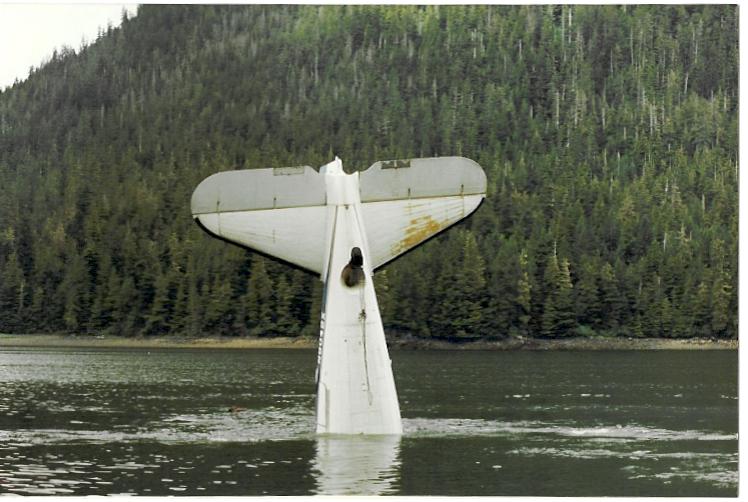
J.R. Nattinger reports this on June 2007
N8042X Petersburg, AK June 26 1989
After a normal take-off a banking turn was initiated. A popping sound was heard
and the pilotís aileron control jammed. The ailerons were still deflected
causing the aircraft to continue rolling. By quickly using rudder and
differential engine power, the pilot somewhat regained roll control of the
aircraft.
During this time or shortly thereafter the copilot had confirmed that his
aileron control was also frozen in the turning position. Looking out at the
right wing the copilot noticed a tear in the fabric of the right aileron, which
was not there prior to take-off.
An attempt to land the aircraft back at the airport was determined to be too
risky as they had no aileron control and other control inputs were near there
maximum just to keep the aircraft level.
Wrangell Narrows provided the nearest, safe landing strip with plenty of room to
make adjustments if necessary (no fire equipment needed there either and the
aircraft was full of fuel). The decision to ditch the aircraft was made. The
distress call was issued and intentions made known.
Shortly before splashdown another popping sound was heard. The copilot noticed
his control yoke to be level and suggested he might have regained aileron
control input authority (not exactly in those words). As the aircraft was
moments away from impact and the pilot could not be sure as to the nature of the
failure he shrugged off this suggestion. The copilot agreed with the decision as
there was no time (or altitude) for trial and error.
The aircraft was ditched and the crew rescued by a fishing boat. The crew with
the help of the fishing boat skipper attempted to tow the aircraft towards shore
to make salvaging her easier but the rope broke and she sank.
After the aircraft was salvaged and examined, the chain was found broken on the
pilotís side but amazingly the copilots yoke was working properly.
My conclusion:
When the pilots yoke chain broke it jammed in between the gear and housing thus
disabling the co-pilots aileron control as well. The second popping sound was
the chain coming free from its jammed position and indeed at that time control
could have been regained. But could it have jammed again?
The decision to ditch the aircraft was the only safe option.
The crew survived thanks to the pilotís quick recovery and expert job of
ditching the aircraft.
The NTSBís five minute phone interview did not capture the all of the details
and lead them to their flawed conclusion. (Ref. SEA89FA122)
J.R. Nattinger
CoPilot N8042X
Hope she is rebuilt or displayed one day
NTSB report provided by J.R. Nattinger below
NTSB Identification: SEA89FA122 .
The docket is stored on NTSB microfiche number 40826.
14 CFR Part 91: General Aviation
Accident occurred Monday, June 26, 1989 in PETERSBURG, AK
Probable Cause Approval Date: 1/23/1992
Aircraft: DOUGLAS DC-3C, registration: N8042X
Injuries: 2 Uninjured.
IMMEDIATELY AFTER TKOF AT 200-300 FT AGL, A PORTION OF FABRIC SEPD FROM THE R
AILERON. WHILE MANEUVERING THE ACFT THE PLT'S CONTROL WHEEL BECAME FREE, AND HE
ELECTED TO DITCH USING FULL RUDDER & DIFFERENTIAL POWER. EXAM OF THE PLT'S
CONTROL WHEEL AILERON CONTROL CHAIN REVEALED THAT THE CHAIN FAILED DUE TO
OVERLOAD. THE RIGHT SEAT WAS OCCUPIED BY A MECHANIC EMPLOYED BY THE OPERATOR AND
HELD A PRIVATE PLT CERT WITH SINGLE & MULTIENGINE RATING. HE STATED THAT HE
SUGGESTED TO THE PLT THAT HIS CONTROLS WERE FUNCTIONING NORMALLY, BUT THE PLT
DISAGREED & PROCEEDED TO DITCH THE ACFT. EXAM OF THE RIGHT CONTROL YOKE
REVEALED AILERON MOVEMENT IN THE CORRECT DIRECTION.
The National Transportation Safety Board determines the probable cause(s) of
this accident as follows:
THE PILOT'S IMPROPER DECISION TO DITCH THE AIRCRAFT WHEN IT COULD HAVE BEEN
FLOWN BACK TO THE AIRPORT USING THE RIGHT SEAT CONTROLS. CONTRIBUTING FACTOR(S)
WAS: THE FAILURE & SEPARATION OF A PORTION OF THE RIGHT AILERON FABRIC, AND
THE PILOT'S EXCESSIVE FORCE APPLIED TO THE CONTROL WHEEL WHICH RESULTED IN
OVERSTRESSING THE AILERON CONTROL CHAIN.
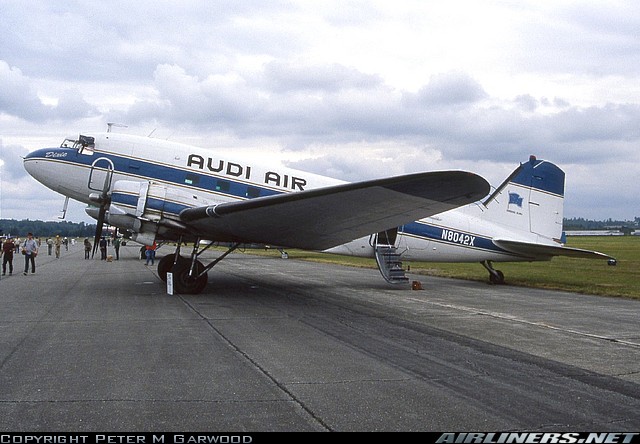
This picture below was taken in 2005 by Mark Perty, it is uncertain what is to become Dixie now?
